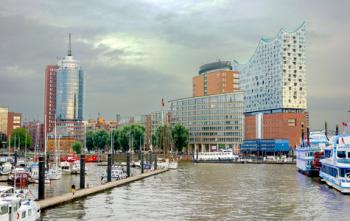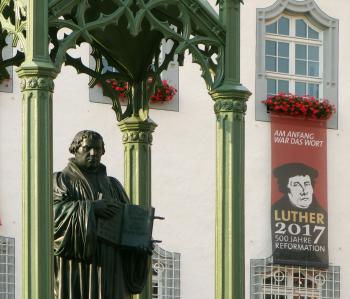What’s new in Germany, Spain and Portugal
This item appears on page 56 of the April 2017 issue.
What’s new in Germany, Spain and Portugal
There’s plenty going on in GERMANY in 2017.
• The big news is the 500th anniversary of the Protestant Reformation. The Reformation began in 1517 when Martin Luther, a priest and professor of theology, wrote and published his 95 theses, questioning the corrupt ways of the Catholic Church. Throughout Germany, visitors will find events and exhibits honoring this anniversary, highlighted by three special exhibitions running from April until November in three different cities.
In Berlin, “The Luther Effect” exhibit, presented by the German History Museum and on display at the Martin-Gropius-Bau exhibition space, will examine the global effect of the Reformation, including in the United States.
At the Luther House museum in Lutherstadt Wittenberg, where he lived and preached, the exhibit will focus on the early days of Luther and the Reformation, highlighted by some of his writing plus his personal Bible with handwritten notes.
The third exhibit, covering Luther’s effect on five centuries of German culture and history, will be at Wartburg Castle in Eisenach, where Luther hid for 10 months after refusing to disavow his statements. He spent that time translating the New Testament from the original Greek into German, thereby bringing the Bible to the masses.
And throughout 2017, my one-hour “Rick Steves’ Luther & the Reformation” special will air on public television throughout the US (or find it at www.ricksteves.com).
• Outside of the many Luther commemorations, visitors will also find a number of German cities and sights in the midst of redevelopment and renovation projects. In Munich, a futuristic overhaul of the main train station is set to start this year.
Major renovations are also taking place at the main branch of the Deutsches Museum, Germany’s version of the Smithsonian. During this time, a number of exhibits will be tucked away out of sight.
• Better late than never, Hamburg’s striking (and strikingly over-budget) Elbphilharmonie, the centerpiece of its HafenCity harbor redevelopment, has finally been completed and is open to visitors. The building houses a concert hall, viewing plaza and hotel. Visitors can ride a 270-foot-long escalator called the “Tube” to the plaza level, which features an outdoor promenade and grand harbor views.
• Frankfurt’s Museum Judengasse, located at the Holocaust Memorial, has reopened and now covers Jewish history in the city before 1800. When the Jewish Museum near the river reopens in 2018, it will cover the period from 1800 to the present.
• At Frederick the Great’s New Palace in Potsdam, two showstopper rooms have reopened after an extensive renovation: the Marble Hall, with its dramatic, 52-foot-high ceiling, and the Grotto Hall, featuring marble walls encrusted with thousands of seashells, semiprecious stones and fossils. The observation tower and platform at another palace building — the Italian-style Orangery — is closed for renovation until 2018.
•
• Neglected corners of SPAIN’s cities are being made more inviting for visitors. Sevilla’s Triana neighborhood, long considered the “wrong side of the river,” is becoming the most colorful and authentic part of town.
Just across the Guadalquivir River from the city center, it now hosts a bustling fruit-and-vegetable market, numerous tapas bars and the Museo de la Cerámica de Triana, which highlights the district’s tile-producing history.
After visiting the museum, it’s fun to wander and admire the lavishly decorated facades of the ceramics workshops that once populated this quarter.
• In Madrid, the formerly sleazy, no-go Chueca district, just north of the busy shopping street called Gran Vía, is now trendy and appealing. It feels like today’s Madrid… without the tourism. Eating there is especially fun, either at a table on the main Plaza de Chueca, at the San Antón market hall or at one of the creative eateries nearby.
• The exception to this upward trend is in Barcelona, where the iconic Ramblas boulevard has lost much of its charm. Once home to authentic markets, characteristic eateries and a thriving local ambiance, it’s now awash in tacky tourist trinkets and lousy restaurants. Still, if you go to Barcelona, you’ve got to ramble the Ramblas (just don’t eat or shop there).
• Barcelona is home to many great buildings designed by Antoni Gaudí, the famous Modernista architect. With the opening of the Gaudí Exhibition Center, there is finally a single place to learn about his contributions to the city.
Filling a complex of ancient and medieval buildings alongside Barcelona’s cathedral, the center uses a beautifully lit, well-described exhibit and plenty of historic artifacts to introduce the man and his accomplishments.
• To accommodate a steadily increasing influx of visitors in this wildly popular city, Barcelona’s main attractions are getting wise to advance ticket sales. For instance, visitors now can save time at the line-plagued Picasso Museum by buying timed-entry tickets in advance.
For last-minute types, another option is to buy an Articket BCN, which covers six top Barcelona museums and allows visitors to walk right in anytime at the Picasso Museum.
Likewise, at the Sagrada Família, Gaudí’s remarkable unfinished church, it’s best to purchase advance tickets through the website. However, ticket buyers now must decide at that time if they want to add the audio guide, tower elevator, live guide or the Gaudí House; there’s no option to buy these extras once inside the church.
Casa Batlló and La Pedrera, two more popular Gaudí sights, now offer pricey fast-pass tickets (in addition to regular advance tickets). People with fast-pass tickets can bypass all lines, including those to enter each building and to access certain areas of the site, such as the roof, that are closed to non-VIP guests.
•
• In PORTUGAL, Lisbon’s recently opened Aljube Museum of Resistance & Freedom covers the country’s troubled mid-20th century history.
Once a prison that held political opponents of Portugal’s longtime dictator Antonio Salazar, the building now houses a well-presented, 3-floor exhibit about the repressive regime, which endured from 1926 until 1974. It’s food for thought for anyone with an appetite for recent history.
At Lisbon’s fine Museum of Ancient Art — covering the 15th and 16th centuries, a time when the Portuguese ruled the seas — a planned renovation may cause disruptions or even closure in 2017.
• Extra crowds are expected this year at the Catholic pilgrimage site of Fátima, which celebrates the centennial of the Virgin Mary’s apparition to three young villagers in 1917.
To learn more about this event, travelers can check out the new Miracle of Fátima Interactive Museum, which features a 40-minute multisensory re-creation of this apparition. The admission fee is steep and the tone is evangelical, but it’s probably the best of the commercial attractions in town.
• In Lagos, on Portugal’s southern Algarve coast, the Slave Market Museum (Mercado de Escravos) has been completely renovated, with new exhibits telling the sad history of Europe’s first modern-era slave market (founded in 1444).
• As it has in much of urban Europe, Uber has come to Portugal. It’s a good, cheap way to get around in hilly Lisbon and Porto.
And there’s another fun new option in both towns: goofy little tuk-tuks (3-wheeled taxis). Find a likeable driver with good language skills and a little charm, and negotiate a private tour. The vehicles are just right for getting into back lanes and making impromptu photo stops.
Rick Steves writes European travel guides and hosts travel shows on public TV and radio. Contact Rick Steves’ Europe (Edmonds, WA; 425/771-8303, www.ricksteves.com).


